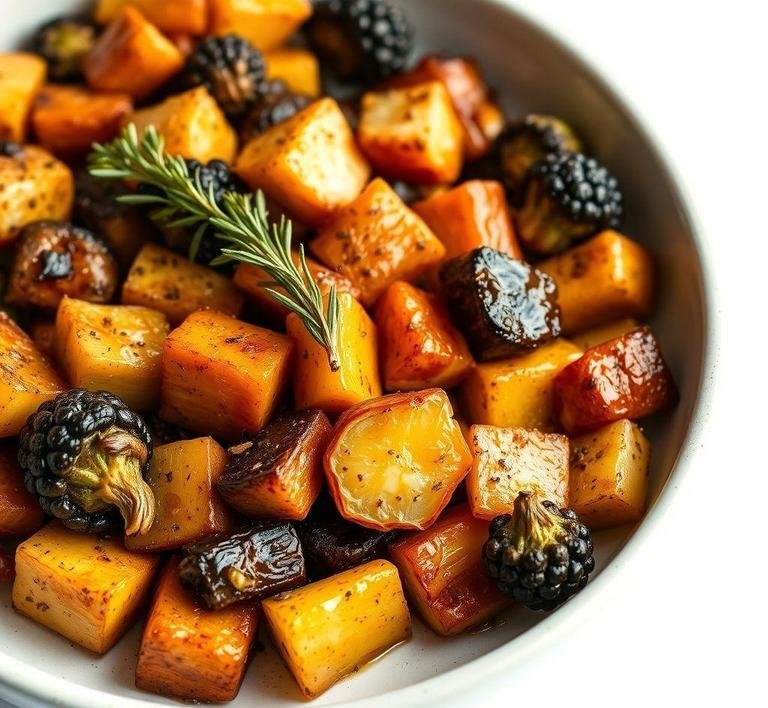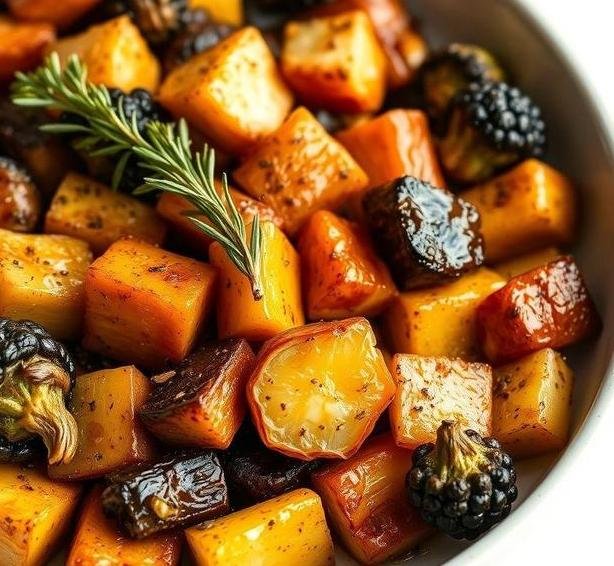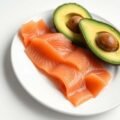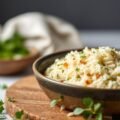Mary Berry’s Honey Roasted Winter Vegetables is a quintessential dish that embodies the warmth and hearty nature of winter cooking. It combines a medley of seasonal vegetables, like carrots, parsnips, and sweet potatoes, with the richness of honey and the aromatic depth of herbs and spices. The vegetables are roasted to perfection, resulting in a beautiful caramelization on the edges while retaining their natural flavors and textures. The dish strikes a perfect balance between savory and sweet, with the honey adding a subtle sweetness that complements the earthiness of the root vegetables.
This recipe is typically enjoyed as a side dish, especially during colder months or festive occasions. It pairs wonderfully with roast meats, such as turkey, lamb, or beef, making it a favorite at Christmas dinners, Thanksgiving, or Sunday roasts. The beauty of Mary Berry’s Honey Roasted Winter Vegetables is its simplicity and versatility-it can be customized with different vegetables or adjusted to suit personal tastes.
Mary Berry, a British culinary legend, is known for her ability to elevate simple ingredients into comforting yet sophisticated dishes, and this recipe is a shining example of that talent. Whether you’re an experienced home cook or a beginner, the instructions are straightforward, allowing anyone to recreate this dish with ease.
Mary Berry’s Honey Roasted Winter Vegetables Recipe
Ingredients Needed

For this recipe, you’ll need the following ingredients, which form the base of the dish:
- Carrots: These provide a natural sweetness and a slight earthiness that complement the other root vegetables.
- Parsnips: Known for their nutty flavor, parsnips bring a subtle depth to the dish. They roast beautifully, becoming tender and slightly caramelized.
- Sweet Potatoes: Their creamy texture and natural sweetness create a perfect balance with the other vegetables.
- Red Onions: Roasted red onions add a savory touch and a little tang, enhancing the flavor profile.
- Garlic Cloves: Garlic brings warmth and fragrance, infusing the vegetables with an aromatic richness.
- Honey: The star of the dish, honey gives a glossy finish and adds a delicate sweetness that contrasts beautifully with the savory vegetables.
- Olive Oil: This is used to coat the vegetables before roasting, helping them crisp up and ensuring a golden-brown finish.
- Fresh Thyme: Thyme adds an herby, earthy note that works in harmony with the root vegetables.
- Salt and Black Pepper: These seasonings enhance the natural flavors of the vegetables.
- Lemon Juice (optional): A splash of fresh lemon juice can help cut through the sweetness of the honey and add a refreshing contrast.
Equipment Needed
To make Mary Berry’s Honey Roasted Winter Vegetables, you’ll need the following kitchen equipment:
- Baking Tray or Roasting Pan: A large tray is essential to ensure that the vegetables have enough space to roast evenly. A roasting pan with high sides can also work well.
- Sharp Knife: A good, sharp knife will help you chop the vegetables into uniform pieces, allowing them to cook at the same rate.
- Chopping Board: A sturdy surface for chopping the vegetables safely and efficiently.
- Mixing Bowl: To toss the vegetables in the honey, olive oil, and seasoning before roasting.
- Pastry Brush (optional): This can be used to brush additional honey or olive oil onto the vegetables during roasting for extra flavor and a shiny finish.
- Aluminum Foil (optional): If you want to ensure the vegetables stay moist during roasting, covering them with foil for the first part of roasting can help, though it’s not strictly necessary.
Instructions To Make Mary Berry’s Honey Roasted Winter Vegetables
- Preheat the Oven: Start by preheating your oven to 200°C (180°C fan-assisted) or 400°F. This temperature ensures the vegetables cook through while becoming beautifully caramelized on the outside.
- Prepare the Vegetables: Peel the carrots, parsnips, and sweet potatoes. Cut them into even-sized chunks-about 1-2 inches in diameter-so they roast evenly. Halve the red onions and peel the garlic cloves.
- Toss the Vegetables: In a large mixing bowl, combine the chopped vegetables, red onions, and garlic. Drizzle the olive oil over the vegetables and toss them to ensure they are evenly coated.
- Add the Honey and Seasoning: Pour in the honey, ensuring each vegetable piece gets a light glaze. Add a sprinkle of salt, black pepper, and fresh thyme leaves. Toss everything together once more to distribute the seasonings evenly.
- Roast the Vegetables: Spread the vegetables out in a single layer on the prepared baking tray or roasting pan. Make sure they are not overcrowded, as this can cause them to steam rather than roast. Place the tray in the oven and roast for 40-50 minutes, turning the vegetables halfway through for even cooking.
- Finish with Lemon Juice (Optional): Once the vegetables are golden and tender, remove them from the oven. For a burst of freshness, squeeze a little lemon juice over the roasted vegetables before serving.
- Serve and Enjoy: Transfer the honey roasted winter vegetables to a serving dish. They’re ready to be enjoyed as a flavorful side dish alongside your favorite mains.
Tips And Tricks
- Cut Uniformly: To ensure even cooking, cut the vegetables into similar-sized pieces. This will help them cook at the same rate and avoid some pieces being undercooked while others become too crispy.
- Add More Vegetables: Feel free to add other root vegetables like butternut squash, beets, or turnips to the mix. They all roast beautifully and will add different textures and flavors.
- Use Fresh Herbs: While thyme is the most commonly used herb, rosemary, sage, or a combination of all three can offer a unique flavor twist. Fresh herbs work best, but dried herbs can be used in a pinch.
- Honey Variations: Experiment with different types of honey. A floral honey will provide a milder sweetness, while a stronger honey like buckwheat honey will lend a more robust flavor.
- Give it a Glaze: For an even shinier, stickier finish, brush the vegetables with a little more honey halfway through roasting. This will give them an extra glossy coat and a touch of sweetness that makes the dish even more indulgent.
- Make Ahead: You can prepare the vegetables in advance by chopping them and storing them in an airtight container in the fridge. When ready to cook, toss them with the oil, honey, and seasonings before roasting.
- Roast in Batches: If you’re preparing a large quantity, roast the vegetables in two or more batches. Crowding the pan will prevent proper roasting, causing the vegetables to steam instead of crisp up.
Mary Berry’s Honey Roasted Winter Vegetables is a perfect example of simple ingredients elevated into something truly spectacular. The dish strikes a delicate balance between the natural sweetness of the vegetables and the rich, caramelized flavor of the honey. It’s easy to prepare, yet impressive enough to be a star on any festive table. Whether you’re preparing a holiday feast or simply want a comforting side dish for a weeknight dinner, this recipe is sure to become a go-to favorite. The versatility of the vegetables and the ability to tweak the recipe with different herbs or additional ingredients makes it a dish you can make your own. So, gather your ingredients, preheat your oven, and let the sweet aroma of honey roasted vegetables fill your kitchen!
Easy Recipe Variations For Mary Berry’s Honey Roasted Winter Vegetables

Mary Berry’s Honey Roasted Winter Vegetables recipe is a timeless classic, offering a perfect blend of sweet and savory flavors that make it a hit during colder months. But, as with any beloved recipe, there’s always room for personalization and fun twists! Below are several easy and exciting variations you can try to keep things fresh, while maintaining the dish’s warm and comforting essence.
1. Add Some Spice
While the recipe itself offers a delightful sweetness from the honey and natural flavors from the root vegetables, you can kick things up a notch with a dash of spice. Add a teaspoon of ground cinnamon, or even some ground ginger, to the roasting vegetables. If you like a bit of heat, chili flakes or a touch of cayenne pepper can add a subtle kick that contrasts beautifully with the honey’s sweetness.
2. Herb Infusion
If you’re fond of herbal flavors, rosemary and thyme work wonders in this dish. You can either scatter fresh sprigs of rosemary or thyme over the vegetables before roasting or toss the vegetables in a tablespoon of olive oil infused with garlic and herbs. The herbal aromas will infuse the honey-roasted vegetables, giving them an extra layer of depth.
3. Root Vegetable Substitutes
If you’re in the mood for variety or simply don’t have the specific root vegetables on hand, feel free to swap out the regular carrots, parsnips, and sweet potatoes with alternatives like turnips, rutabaga, or celeriac. These vegetables will still roast beautifully with honey and offer a slightly different flavor profile.
4. Add Some Fruits
For an even more complex dish, consider adding some fruits to the mix. Pears, apples, or figs pair excellently with honey and roasted vegetables. Just be sure to add them midway through the roasting process to prevent them from overcooking. Their natural sugars will caramelize in the oven, giving your dish a touch of extra sweetness.
5. Nutty Delight
Adding some toasted nuts to your honey-roasted vegetables can enhance both the texture and flavor. Try sprinkling in a handful of roasted walnuts, pecans, or even hazelnuts during the last 10 minutes of roasting. The nuts will take on a delightful crunch while complementing the vegetables’ softness, adding a perfect contrast.
6. Vegan Twist
To make the recipe vegan-friendly, swap out the honey for maple syrup or agave nectar. These alternatives will still provide a lovely sweetness but with a slightly different nuance. Ensure you’re using vegan-friendly butter or olive oil to complete the dish. The roasted vegetables will still shine with rich, caramelized edges.
7. Mediterranean Flair
For a Mediterranean-inspired version, consider adding olives and a sprinkle of feta cheese in the final moments of roasting. A drizzle of balsamic glaze after roasting will elevate the flavor, creating a rich contrast with the honey’s sweetness. This variation introduces a saltier, tangy bite that perfectly balances the vegetables’ sweetness.
Storing Leftovers
Mary Berry’s Honey Roasted Winter Vegetables are a comforting and satisfying dish, but if you find yourself with leftovers, don’t worry! Storing them properly will ensure they maintain their delicious flavor and texture. Here’s a guide to keeping them fresh:
1. Refrigerating Leftovers
The easiest way to store your leftover roasted vegetables is by placing them in an airtight container in the fridge. Ensure the vegetables are cool before storing them, as hot vegetables can create moisture inside the container, leading to sogginess. When stored this way, the vegetables can last for about 3-4 days.
If you have any leftover honey glaze, store it separately and drizzle it over the vegetables when reheating. This will help refresh the dish and revive its original caramelized sweetness.
2. Freezing For Later
While roasted vegetables can lose some of their crispness when frozen, they still freeze well for later use. To freeze your honey-roasted vegetables, lay them flat on a baking sheet and place them in the freezer for 1-2 hours. This prevents the vegetables from sticking together in one large clump. Once they’re frozen, transfer them to a freezer-safe bag or airtight container and store them for up to 3 months.
When you’re ready to use them, simply reheat them from frozen in the oven or on the stovetop. Keep in mind that freezing may soften the vegetables, but they’ll still taste just as delicious, especially when paired with a warm sauce.
3. Reheating
To reheat leftovers, simply pop them back in the oven at 350°F (175°C) for 15-20 minutes until they’re heated through and slightly crispy on the edges again. Alternatively, you can reheat them in a skillet with a touch of olive oil or butter to bring back some of the original crispiness.
4. Creative Leftover Uses
Leftover honey roasted vegetables can also be incorporated into other meals. Consider tossing them into a salad, stirring them into a grain bowl, or using them as a topping for flatbreads or pizzas. They can also be blended into a creamy soup or served as a side dish with roasted meats or tofu.
What To Eat With Mary Berry’s Honey Roasted Winter Vegetables?
Mary Berry’s Honey Roasted Winter Vegetables are a versatile side dish that pairs beautifully with a wide variety of main courses. Here are some excellent pairing ideas to create a full, well-rounded meal:
1. Roasted Or Grilled Meats
The sweetness of the honey and the savory roasted vegetables complement many roasted or grilled meats. Whether it’s a succulent roast chicken, tender lamb, or crispy pork belly, the honey-roasted vegetables will provide the perfect balance to the richness of the meat. For a hearty meal, serve the vegetables alongside a well-seasoned roast and a side of mashed potatoes or crispy potatoes.
2. Hearty Grains
For a lighter but equally satisfying meal, serve the roasted vegetables over a bed of warm quinoa, couscous, or farro. The nutty flavors of the grains will complement the sweetness of the honey glaze and provide a wholesome, plant-based meal option. Add a drizzle of olive oil or a dollop of yogurt to add creaminess.
3. Vegetarian & Vegan Options
If you’re serving vegetarians or vegans, pair the vegetables with a protein-packed dish like lentil stew, chickpea curry, or a tofu stir-fry. The hearty nature of these dishes will complement the roasted vegetables without overwhelming their delicate sweetness. Adding a sprinkle of crumbled feta or a tahini drizzle can bring in additional flavor layers.
4. Grilled Fish Or Seafood
If you prefer fish, consider pairing the honey roasted vegetables with grilled salmon, sea bass, or a delicate white fish. The earthy sweetness of the vegetables offers a lovely contrast to the slightly smoky flavor of grilled fish. A squeeze of lemon over both the fish and the vegetables will add a refreshing note.
5. A Fresh Green Salad
For a lighter side dish, serve the vegetables with a crisp green salad. A mix of arugula, spinach, or kale works well with the warm, roasted elements. Add a tangy vinaigrette or a lemon-based dressing to brighten up the dish and provide some contrast to the roasted vegetables’ richness.
Conclusion
Mary Berry’s Honey Roasted Winter Vegetables are the ultimate comfort food, offering both simplicity and sophistication in a single dish. The natural sweetness of the honey, paired with the caramelized richness of the root vegetables, makes for a perfect seasonal side that can accompany almost any meal. Whether you’re looking to switch things up with some fun variations, store your leftovers for later, or figure out what to pair it with, this dish is both adaptable and forgiving. The possibilities are endless, and the leftovers can be just as satisfying as the original meal. So, whether you’re serving it for a family dinner, a holiday feast, or just as a comforting side, Mary Berry’s Honey Roasted Winter Vegetables are sure to be a crowd-pleaser every time.
FAQs
What Vegetables Are Best For Mary Berry’s Honey Roasted Winter Vegetables Recipe?
Mary Berry’s honey roasted winter vegetables recipe typically uses a combination of root vegetables that are hearty and suitable for roasting. Popular choices include carrots, parsnips, sweet potatoes, and butternut squash. You can also add red onions, Brussels sprouts, and even some turnips or celeriac for variety. The key is to choose vegetables that will hold up well during roasting and absorb the honey glaze, giving them a rich, caramelized flavor.
How Do You Make The Honey Glaze For The Roasted Winter Vegetables?
To make the honey glaze for Mary Berry’s recipe, you combine honey with a little olive oil, balsamic vinegar (or lemon juice for a lighter touch), and seasonings like salt and pepper. You can also add herbs such as thyme or rosemary for extra flavor. The glaze is then drizzled over the vegetables before roasting, helping them caramelize and become tender with a sweet and savory coating.
Can I Make Mary Berry’s Honey Roasted Winter Vegetables In Advance?
Yes, you can prepare Mary Berry’s honey roasted winter vegetables in advance. You can chop the vegetables and make the honey glaze ahead of time. Simply store the chopped vegetables in an airtight container in the fridge, and keep the glaze in a separate jar. When you’re ready to cook, toss the vegetables with the glaze and roast them according to the recipe’s instructions. If you want to roast them in advance, you can reheat them in the oven just before serving, although they may not be as crisp as when freshly roasted.


